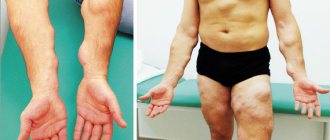Reasons for the formation of bumps behind the ears
There are a number of health problems that can cause lumps and lumps to form behind the ears. It is most likely that this problem may occur with the following diseases:
- mastoiditis;
- otitis media;
- infection;
- abscess;
- lymphadenopathy;
- acne;
- fat cyst.
If you find any suspicious growths, for example, a ball behind the ear, you should immediately consult a doctor. Our clinic specialists are ready to conduct an examination, determine the causes of the disease and prescribe the necessary treatment.
Why does the jaw hurt near the ear: the main causative factors
Soreness in the jaw with radiation to the ear can provoke various pathologies.
Dental problems
Dental diseases are often accompanied by pain, which can radiate to different parts of the head, including the area near the ear. Possible reasons for the appearance of an unpleasant symptom:
- caries at different stages of development, pulpitis;
- abscess;
- damage to prostheses - crowns or implants;
- glossitis - inflammation of the tongue;
- cyst or granuloma of the tooth root;
- gum disease – gingivitis, periodontitis;
- periostitis is an inflammatory process in the periosteum.
Pain in the jaw is often associated with procedures performed by the dentist, for example, teeth cleaning or whitening, their treatment or removal, implantation, or installation of braces. Irradiation into the ear is observed when the figure eight erupts and its position is incorrect.
A problem such as bruxism can also provoke pain. When it is present, the jaw muscles unconsciously contract, causing severe teeth clenching and friction. A characteristic grinding sound occurs. Often a person is not aware of the presence of bruxism, since it usually occurs at night. A disorder can be suspected by the presence of discomfort in the facial muscles in the morning. Due to the strong tension, pain is also felt in the jaw, and microcracks form on the enamel.
Disorders of the temporomandibular joint
TMJ problems are the most common cause of non-dental pain in the facial area. Joint dysfunction is provoked by various disorders in the mobility of the system of muscles, ligaments, cartilage and bones. Pain may appear on the left or right, as well as on both sides. The main symptoms of TMJ dysfunction:
- pain near the ear when swallowing, chewing, yawning, talking;
- dizziness;
- visual impairment;
- noise in ears;
- headache.
The disease is also diagnosed by a characteristic click when opening the mouth. TMJ injuries (dislocations, fractures) are accompanied by bruising, swelling, and redness. You can get them from a blow or bruise. Often the jaw disc is displaced forward, and the head of the lower jaw is shifted backward. This provokes stretching of the anterior and posterior disc ligaments and pressure on the bilaminar area of the joint, where pain receptors are located.
The TMJ can be affected by arthritis and arthrosis. In the first case, severe night pain, crunching and clicking, and stiffness in the morning appear. In the second, the pain is aching and chronic in nature and increases with yawning and opening the mouth. Pathology is provoked by various reasons: age-related changes, stress, inflammation, trauma and genetic predisposition.
Disturbances in the functioning of the TMJ are observed with the habit of clenching or moving the jaw, with bruxism, and constant chewing of gum (the joint does not have time to rest after eating food). Causes wear and tear and malocclusion. Chewing food on one side provokes increased pressure in this area. Over time, damage to the TMJ affects the nerve endings, which explains why pain occurs.
Neurological diseases and vascular pathologies
Trigeminal neuralgia is a disease that causes sharp pain in different parts of the face. It all depends on which branch is affected (there are three of them). Unpleasant symptoms may intensify when chewing, talking, pressing on the face, or brushing teeth. In addition to the trigeminal nerve, pain near the ear can provoke damage to other nerves:
- wandering;
- glossopharyngeal;
- occipital
Arteritis, in which acute pain appears due to muscle spasms, can provoke malaise. Deformation is visually observed, and compaction is visible on the x-ray. Characteristic symptoms include swelling and redness of the affected area. Pain in the jaw, which radiates to the ear area and other areas of the face, may indicate diseases of the brain, in particular, circulatory disorders of this organ.
Painful sensations near the ear can be the result of damage to blood vessels, for example, the carotid artery. In this case, the neck, jaw and facial part are affected.
Oncological factor
As cancer develops, pain often appears on the right side. The tumor can be malignant or benign. In the first case, the nerve endings first lose sensitivity, and numbness of the face appears. After this there is pain in the jaw. In the second case, unpleasant sensations in this area are also observed. A lump appears near or behind the ear - a consequence of the growth of a lymph node. In this case, it is important to take measures to prevent an inflammatory or purulent process from starting. In addition to pain near the ear, other symptoms associated with a benign tumor include:
- deterioration of general condition;
- increased body temperature;
- headache;
- redness of the tumor.
If suppuration occurs, this already poses a danger to the patient’s life. Lack of proper care can lead to infection entering the bloodstream.
Otitis media
Otitis media is another type of ear infection that can be of either viral or bacterial origin. This disease is characterized by the appearance of a lump behind the ear, which is quite painful and can cause swelling. This disease leads to a tumor noticeable even to the naked eye.
Treatment of such pathologies involves the use of potent antibiotics, which can not only alleviate the symptoms, but also fight the infection. Correct treatment can only be prescribed by an experienced doctor who will conduct a full examination to confirm the diagnosis.
Diagnostics
To find out the reason for the appearance of a lump on the jaw, a comprehensive examination is prescribed. First, the doctor examines and collects the patient’s complaints. If a patient has lymphadenitis, at the initial stage of the disease the following symptoms appear:
- slight enlargement of lymph nodes, their mobility;
- pain of the nodes on palpation, turning the neck (pain can radiate to the ear or other parts of the body nearby);
- general weakness;
- low-grade temperature ;
- decreased sleep quality;
With inflammation of the lymph nodes, accompanied by purulent processes, the patient has complaints of:
- increased pain when moving the jaw;
- redness of the skin in the area where pus accumulates;
- severe swelling of the lymph nodes, their pain even without pressure;
- temperature rise to 38 ºC or more.
In the last stages of lymphadenitis, the patient’s well-being deteriorates significantly: inflammatory processes spread to the neck and shoulders, fever appears, and bluish skin is observed at the site of inflammation.
Since, in addition to inflammation of the lymph nodes, there are other reasons for the appearance of lumps on the jaw, it is impossible to make a correct diagnosis based on the clinical manifestation of the pathology. Therefore, laboratory and instrumental diagnostic methods are used.
The patient is prescribed:
- blood test (general, advanced);
- bacteriological examination of mucus from the tonsils and upper respiratory tract;
- radiography of the jaw (in different projections);
- ultrasound examination of pathological formation;
- CT or MRI of the head;
- biopsy (if necessary).
Regardless of the mechanism of occurrence of a lump on the jaw, it is important to begin taking therapeutic measures in a timely manner. The earlier treatment is started, the lower the risk of complications.
Lymphadenopathy
Lymphadenopathy is a secondary infection of the throat or ear that begins its development from the lymph nodes. These organ-like structures are small structures located throughout the human body, including the pelvis, armpits, neck and ears.
With the development of infectious diseases, the lymph nodes will become inflamed, which is the immune system’s reaction to the pathogens. The bumps located behind the ears will gradually increase in size. Therefore, if you suspect lymphadenopathy, you should immediately contact qualified specialists.
Benign tumors of the ear
Benign tumors of the middle ear include hemangioma and various neurogenic neoplasms. Hemangiomas of the middle ear are manifested by the following symptoms:
- Decreased hearing;
- Ear congestion;
- Feeling of noise.
Often the first symptom of the disease is a slowly occurring paralysis of the facial muscles on the side where the hemangioma is located. For middle ear hemangioma, otolaryngologists usually perform abdominal surgery or widely remove the mastoid process.
Chemodectoma of the middle ear develops from glomus bodies, which are normally located at the bottom of the tympanic cavity, on the dome of the bulb of the internal jugular vein and in the temporal bone. They differ in structure from glomus bodies, which are located in other areas. Depending on the histological structure and the ratio of cell accumulations, there are 3 types of glomus tumors: adenoid-like, alveolar and angioma-like. According to the clinical course, limited and widespread forms of chemodectoma are distinguished.
Diagnosis of chemodectoma is carried out using radiography of the jugular fossa, pyramid of the temporal bone, attic-antral region, mastoid process. X-ray examination includes radiography of the temporal bone in three main projections and tomography in direct and lateral projections.
Chemodect treatment is surgical. Small tumors that do not destroy the eardrum are removed or exposed to ultra-low temperatures. Tumors that have spread to the external auditory canal, mastoid process, or antrum are also subject to surgical treatment. Otolaryngologists perform operations of varying scope - from tympanotomy to extended radical surgical interventions on the ear. Sometimes cryotherapy is used. For tumors that destroy the pyramid and spread into the cranial cavity, external gamma irradiation is performed, which often causes growth arrest or a decrease in chemodectoma.
Acne
Acne occurs as a result of clogged hair follicles and occurs mainly in teenagers. Once oil and dead skin cells accumulate in the pores, pimples or nodules can form. In some cases, neoplasms can be quite impressive in size, hard in structure, and quite painful.
In our clinic, you can make an appointment with an experienced doctor who will conduct an examination, tell you what to do if there is a lump behind your ear, and, if necessary, prescribe additional examinations.
Osteoma in the ear
Osteoma in the ear (exostosis, osteophyte) develops mainly from the compact layer of the posterior wall of the bony part of the external auditory canal. Much less often, neoplasms are found on the lower and upper walls of this section. Endophytic osteomas penetrate into the mastoid process. Osteoma is a benign tumor that grows rather slowly.
Osteoma has the appearance of a round formation, which is covered with a skin layer, very dense when palpated with a Vojacek probe. It is treated surgically. The operation is performed after the tumor has grown to medium size. In this case, removing the tumor is technically as convenient as possible. If the tumor is small, there is a risk of not completely removing the pathological tissue. If the osteoma is large, it is possible to capture a significant part of the healthy bone tissue during surgery. This will cause a large bone defect.
Pathogenesis
Excessive growth and proliferation of cells during the formation of neoplasia usually involves structural elements of the skin, subcutaneous fat, cartilage, bone, vascular networks and nerve sheaths. The mechanism of development is based on malignant metaplasia.
Benign angiomas are considered the most complex, because in this case the tumor in the ear is represented by telangiectasias or repeating networks of veins and capillaries, which can have expansions in the form of cavities. They are prone to bleeding.
When the sebaceous glands are blocked on the earlobe, atheroma - an epidermal cyst of the sebaceous glands. It is usually encapsulated, smooth and round in shape, the contents of the thick mass contain fat, cholesterol , detritus and epithelium. It can grow over time, fester and break through.
Anatomy of the auricle
Epitheliomas (carcinomas) of the ear are localized at the top of the helix and begin with a warty nodule, which gradually enlarges and spreads over the entire auricle, gradually “corroding” it and causing overgrowth of the ear canal. A detailed study of neoplasia reveals atypical keratocytes (with deposits of keratin ), in which the process of normal cell maturation is distorted, starting from the spinous layer and ending with the upper layer of the epidermis. Tumor cells exhibit a high percentage of pleomorphism and numerous mitotic figures. In other cases, the oncological process immediately begins with the condition of an ulcer, which has limited edges and a tendency to spread in depth and breadth. Penetration of more than 4 mm and extension of 2 cm significantly increases the risk of malignancy. In both cases, regional lymph nodes are involved in the pathological process.
Squamous cell carcinoma of the ear
In children, sarcomas with round-cell, spindle-cell osteo-, angio- and melanosarcoma are more often found. The size and consistency may vary, the color from bluish to red.
The disease is usually characterized by a long-term benign course, which is replaced by rapid tumor growth, ulceration of the skin and exposure of bleeding masses, which then disintegrate. In some cases, a malignant ear tumor grows from the mesenchymal tissue remaining in the newborn in the supratympanic space.
General information
Oncology of the auricle is a less common type of pathology, however, we should not forget the threat it can pose. In 85-90% of cases, tumors are localized on the auricle and in approximately 10-15% the tumor is localized in the middle ear.
Among the most common benign tumors of the outer ear are fibromas and papillomas , and more rare ones are chondromas , lipomas and angiomas . Malignant formations are represented by sarcomas (oncology is more often diagnosed in children) and directly cancerous tumors ( carcinomas , melanoblastomas ), which are more susceptible to adults and elderly people.
Treatment and prevention of atheroma
Treatment of atheroma is predominantly surgical, with removal of the cavity along with its contents. To do this, a small skin incision is made on the body, through which access to the atheroma is provided. After removing the contents, the cavity is washed, and if necessary, a turunda is inserted for several days to facilitate the release of blood, pus and fat.
The operation is performed not in a hospital setting, but on an outpatient basis. Local anesthesia is used for pain relief. For small atheromas, sutures are not applied, since the skin incision heals on its own after 5-6 days. For large atheromas, cosmetic sutures are applied, which are regularly processed after 1-2 days. The operation itself is painless for the patient, but the danger is that without eliminating the causes that caused the appearance of atheroma, there is a high probability of relapses (almost 50% of all cases). That is why it is so important not only to eliminate the cause of atheroma, but also to take measures to prevent the disease. These include personal hygiene measures and early consultation with a doctor. It is not recommended to treat atheroma on your own.










